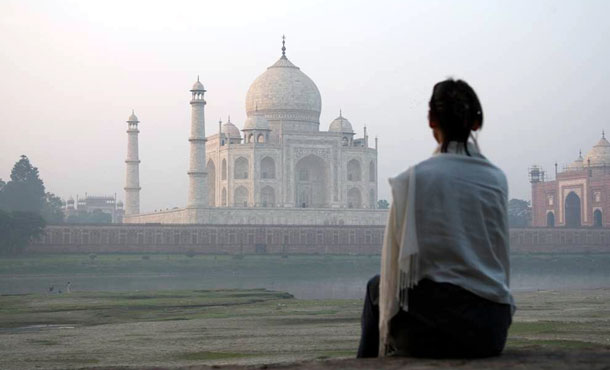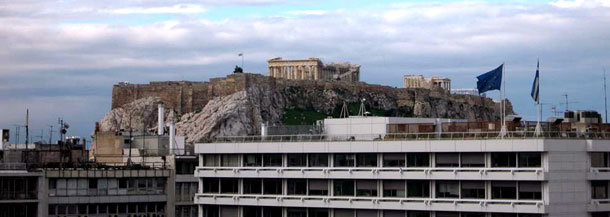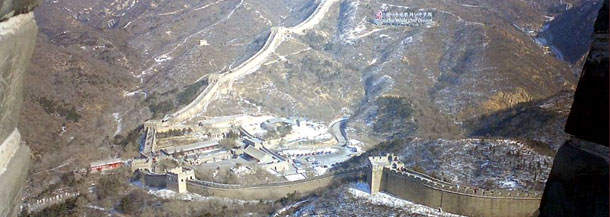The Daily Telegraph - Pick the world's new wonders
June 16, 2007
An ancient list is being updated, through a modern worldwide poll. Michelle Jana Chan looks at the 21 contenders.

On July 7, there will be a new version of the Seven Wonders of the World, a list that has always captured the imagination of travellers. It will be drawn up on the basis of more than 50 million votes cast from people in almost 200 countries.
As we went to press, the front-runners included the Acropolis, Machu Picchu and the Taj Mahal. But as the July 6 deadline for voting nears, supporters of many of the 21 contenders still in the race will do their utmost to ensure that their favourite makes it into the magic seven by urging people to place their votes - either online or by phone.
The short list of 21 includes the only one of the original Seven Wonders that is still standing, the Great Pyramid of Giza, which has been given a special ancient wonder status. The remaining 20 include a mixture of the old and the new: from Stonehenge and the Alhambra in Spain to the Eiffel Tower and the statue of Christ the Redeemer in Rio de Janeiro.
The first seven wonders, which included the Hanging Gardens of Babylon and the Statue of Zeus at Olympia, are believed to have been chosen by the Ancient Greeks as a guide to the must-sees of the Mediterranean. There have since been numerous attempts to redraw the list, including a poll conducted by Teletext Holidays that put the Channel Tunnel in the seven. But this latest venture incorporates the views of far more people.The New7Wonders Foundation was launched seven years ago by a Swiss entrepreneur, Bernard Weber, a man with a passion for architecture and the visual arts and a former curator at Le Corbusier Museum in Zurich. Supporters of his non-profit-making venture include a former director-general of Unesco, Federico Mayor.
In addition to attempting to reach agreement on the seven new wonders, Weber's foundation aims to raise awareness of heritage sites and fund restoration projects. One of its objectives is to reconstruct one of the two Buddhas of Bamiyan, Afghanistan. Built during the 6th century and 125ft and 180ft tall, they were the world's largest standing Buddha statues until 2001, when they were blown up by the Taliban.
Left in peace, those Buddhas might have gone on to become contenders in the current contest, which was open to any heritage site that was man-made and built before 2000. The nominations were whittled down to a short list of 21 last year by a panel of architects. Now, in line with the modern trend for phone-ins, it is time for the public to decide on the final seven.
When the last ranking listing was released on June 7, the top 10 included Petra in Jordan, the Colosseum in Rome and the Pyramid at Chichén Itzá in Mexico. Some of the more modern entrants, such as the Sydney Opera House and the Statue of Liberty, were placed in the bottom 10. Also trailing were Stonehenge, the temples at Angkor in Cambodia and the fabled town of Timbuktu.
One drawback of going with the popular vote is nationalism. If a billion Chinese want the Great Wall or nearly a billion Indians want the Taj Mahal, they will surely both be a shoo-in. Oddly, however, Easter Island, which has a population of 4,000 and is the least visited of the 21 sites, is currently ranked in the top 10, suggesting that the vote is not all about the power of patriotism.
Europe is the continent with most contenders, followed by Asia and South America, but there are candidates from right across the globe.
21 wonders - and how to see them at their best
Acropolis, Athens (450-330 BC)
Excluded from the original Seven Wonders list because it was too close to home for Greek tourists, the Acropolis is a serious contender today. Dominating Athens from its rocky crag, it's the site of four Classical temples including the Parthenon. After visiting the ruins, make a side trip to the Foundation of the Hellenic World, just over a mile away, where the multimedia museum uses virtual reality to show the site as it was during the time of the Ancient Greeks.

Alhambra, Granada (13th century AD)
Testament to a glorious Arabian-African civilisation. Herein lies the sublime Nasrid palace with its arches of intricate plasterwork, reflecting pools and courtyards. It's best seen at night (usually 10pm-11.30pm), when most tourists are in the bars of Granada. For round-the-clock viewing, there are two hotels inside the Alhambra's grounds: the Parador, in a converted medieval monastery and the better value, but simple, Hotel América.
Angkor, Siem Reap, Cambodia (9th-15th century AD)
Not one solitary temple but a 100,000-acre forested area with the remains of different Khmer monuments. The most famous is Angkor Wat, said to be the world's largest religious monument, which is best seen at sunrise. The less frequented Ta Prohm temple is overgrown with strangler fig trees. At sunset, hike up to Phnom Krom to see the colours of Tonlé Sap Lake.
Pyramid at Chichén Itzá, Yucatán Peninsula, Mexico (before 800 AD)
This towering step-pyramid stands amid one of the greatest Mayan archaeological sites and is thought to be a temple and solar calendar. At the equinox, the play of sunlight and shadow creates an image of a plumed serpent moving along the staircase, but it's difficult to see because of the crowds. Best to visit during American term time. Wear shoes with a good grip if you plan to climb the pyramid.
Christ The Redeemer, Rio de Janeiro, Brazil (1931 AD)
With arms outspread in a wingspan of 100ft, this art deco-style figure has become an iconic image of Brazil. If you're pushed for time, skip the cog-train and take a taxi up past Rio's favelas and lush rainforest towards the peak of Corcovado mountain. Take a pair of binoculars to watch the planes land at Santos Dumont airport, in the heart of downtown.
The Colosseum, Rome (70-82 AD)
Once capable of seating 50,000 spectators, this amphitheatre is where ancient Romans watched gladiatorial contests, mythological plays and executions. To avoid long queues, buy a ticket at the Palatine Hill entrance. Sundays are less noisy because the Via dei Fori Imperiali leading to the Colosseum is closed to traffic.
Moai of Easter Island, Chile (10th-16th century AD)
This South Pacific island is famed for its hundreds of giant, enigmatic statues, but is the least visited destination on the short list. That may be understandable given its location halfway between Chile and Tahiti, 2,500 miles away in either direction. Easter Island is served by several flights a week from Santiago. Later this year, a new Explora hotel, Posada de Mike Rapu, will open as the island's first boutique accommodation.
Eiffel Tower, Paris (1887-1889 AD)
Monsieur Eiffel engineered perhaps the world's greatest symbol of romance, but the long queues to ascend the tower can spoil the effect. Avoid waiting in line by booking a table at Alain Ducasse's Restaurant Jules Verne, where diners benefit from a private elevator at the south tower. That alone may be worth the steep prices, but the food is excellent, too (0033 145 556144).
Great Wall of China (220 BC and 1368-1644 AD)
China's first emperor, Qin Shi Huang, built the Great Wall as a defence against northern invaders. It stretches 3,725 miles, from the desert into the Pacific. Around Beijing, avoid the overcrowded section at Badaling and head to the quieter areas at Mutianyu or Simatai. There is a cable car at Mutianyu for visitors who might struggle with the climb. Simatai is the least crowded site but the wall is steep and unstable in places.

Hagia Sophia, Istanbul (532-537AD)
Built on the banks of the Bosporus, this Byzantine masterpiece, which fuses the spirituality and architecture of East and West, has stood as a church for a millennium and a mosque for five centuries. Be sure to climb up to the mezzanine level to see the mosaics. Visitors should dress modestly, and women may be required to cover their head with a light scarf.
Kiyomizu Temple, Kyoto, Japan (749-1855AD)
For 1,000 years, Kyoto was the imperial capital and Kiyomizu Temple is the finest example of the city's development of traditional wooden architecture. The city is filled with Buddhist shrines and elegant Japanese gardens, best seen in March or April when the cherry blossoms are in flower. Planning a trip, however, does run the risk that you will miss the blossom altogether because flowers usually last only a week. The autumn is also a lovely time of year to go.
Kremlin and Red Square, Moscow (1156-1850AD)
Still retaining the aura of early Tsarist Russia, this former royal citadel consists of palaces, armouries and a fortress. St Basil's Basilica, crowned by onion domes, is equally beautiful on the inside. Better spend an hour there than queuing to enter Lenin's Tomb. If you can face the Moscow winter, be among the first to make footprints in the snow across Red Square.
Machu Picchu, Peru (1460-1470AD)
This mysterious citadel on the eastern slopes of the Andes was built at the height of the Inca Empire. It can be visited by train, but that arrives in the middle of the day when the sun is directly overhead. The site is more atmospheric early and late in the day. If you can, hike the Inca Trail from Cuzco, and arrive at the Sun Gate for sunrise.
Neuschwanstein Castle, Schwangau, Germany (1869-1884AD)
The shy King Ludwig II built this fairytale castle amid the meadows and lakes of southern Bavaria as a retreat from public life. Visitors must park their cars in the village of Hohenschwangau, which is where you buy your entrance ticket. From here, it is a 30-minute walk up to the castle. Horse-drawn carriages and buses are also available.
Petra, Jordan (9 BC-40AD)
Half built, half carved into sheer rock by the Nabataeans, an industrious Arab people, this rose-hued city is surrounded by mountains containing tombs and funerary vaults. Most tourists reach Petra by vehicle, but the five-day, 30-mile desert trek from Wadi Feynan is a more rewarding way of arriving here, with support teams to set up camp and carry everything. More information on the website of Jordan's Royal Society for the Conservation of Nature.
The Great Pyramid, Egypt (2600-2500BC)
The only surviving wonder of the ancient world, the Great Pyramid, with its two smaller siblings, is the crowning achievement of ancient Egyptian engineering. Many visitors don't bother with the interior, but it is worth arriving early in the day to secure one of the limited number of entry tickets. Be warned: paths are steep and narrow. The sound- and-light show sounds cheesy but is very popular. You cannot vote for the Pyramid because the Foundation has already designated it honorary ancient wonder status.
Statue of Liberty, New York (1886AD)
Standing at the entrance to New York Harbour, this historic symbol of freedom has welcomed millions of immigrants to the United States. Liberty Island was closed for security reasons after the terrorist attacks of September 2001 but is now open again, albeit with tough screening procedures. Catch the first ferry of the day from Battery Park, when queues are shortest. For the best views, sit on the starboard side on the outbound journey and the port side on the return.
Stonehenge, Wiltshire (3000-1600BC)
The oldest of the 21 finalists and the only British entrant, this Neolithic pattern of stone circles is aligned with the Summer Solstice, which occurs this year at 4.58am on June 21. If you would rather avoid the midsummer frolicking, call English Heritage (01722 343834) to book a special visit outside normal opening hours, when access inside the centre of the stone circle is allowed.
Sydney Opera House (1954-73AD)
This performing arts venue beside Sydney Harbour Bridge is the newest of the finalists, with its design based on complex sections of a sphere. Jorn Utzon, its Danish architect, resigned in controversy before the project's completion because of government resistance to rising costs, but in the past 34 years it has become one of Australia's premier landmarks. To see the opera house from the water, take a ferry from Circular Quay to the beach suburb of Manly.
Taj Mahal, Agra, India (1630 AD)
A testament to Muslim art, this white marble mausoleum was built by the Mogul emperor Shah Jahan in memory of his favourite wife, who died giving birth to their 14th child. Night-time visits are permitted around the full moon but it's least crowded at dawn. From Delhi to Agra, travel by rail is quicker (three hours) and less gruelling than by car. All the rooms at the Oberoi Amarvilas have views of the domed monument.
Timbuktu, Mali (12th century AD)
At its height, this West African city prospered from the trans-Saharan trade in salt and gold along the Niger River, building great universities, libraries and mosques. There are flights here from Mali's capital, Bamako, but the best adventure is to take the four-day ferry service from Koulikoro, about 35 miles east of Bamako, to Kabara, from where it's an eight-mile paved road to the city's gates.




